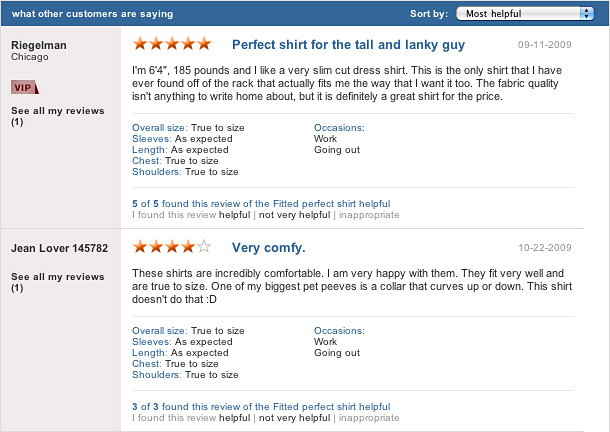Don’t Fear the Reviewer
September 2010
By The Author

Does the idea of allowing your customers to rate your products on your website make you uneasy?
If so, it’s time to reverse your thinking: don’t fear the reviews; fear what their absence is costing you.
Here are four reasons why encouraging your customers to post product ratings will not only strengthen their allegiance to you but also help you capture more sales:
Break through the trust barrier
As we established previously in our article on the
culture of the Web, the Internet collective harbors an inherent mistrust toward all corporate entities, and unfortunately for you, retailers are no exception to that rule.
On the other hand, peer validation is everything. No matter what you do or what you sell, if people love it and vouch for you, you’ll be strongly positioned for success. In the absence of this corroboration, you face a significant burden of proof to overcome the natural skepticism of the collective.
What does this mean for you?
You can spend hours meticulously crafting eloquent descriptions for each and every product you sell, but they will never carry the weight of a review that one of your customers spends five minutes to dash off.
Reviews demonstrate that you stand behind your products and you have nothing to hide.Fair? Perhaps not. True? Absolutely.
It’s all about trust.
However, when it comes to trust, you actually get extra credit for the very fact that you do empower your customers to publish their feedback on your site. For new visitors who may not be familiar with your brand or your reputation, these reviews are a badge of transparency that demonstrate that you stand behind your products and you have nothing to hide.
Tip the scales in your favor
Online shopping is a fact of life in today’s world. However, as commonplace as the act of buying on the Web has become, there is always still a lingering hint of uncertainty that resides with customers because they cannot see, hold and judge an item for themselves before committing to the purchase and paying the associated shipping costs.
This effect is multiplied for certain types of merchandise like clothing and shoes. I may know that I generally wear a size 11 running shoe, but when deciding between different brands and styles, how can I tell whether my chosen shoe will run true to size, offer the level of cushioning I desire and be comfortable for a five-mile jog?
The last thing you want in this situation is for me to give up and go to a bricks-and-mortar store where I can try before I buy, even if it means paying a bit more for that luxury. This is where customer reviews can save the sale by providing the reassurance I need to feel confident that the particular shoe I have selected will meet my expectations.
Turn your customers into salespeople
Returning once again to the qualities that define the
culture of the Web, one of the fundamental characteristics of the Internet collective is their compulsive need to share.
As a result, when someone buys something that they love, it’s practically second nature for them to talk up their purchase on sites like Facebook and Twitter. This tendency is all the greater when they can boast about a particularly unique find or an especially good bargain, as they seek the approbation of those in their social networks. It’s the virtual equivalent of taking a girlfriend along on a shopping excursion and having her
ooh and
ah in approval over your selections.
Why not give your customers a soapbox to exercise their habitual need to share on your own site, where their opinions can help persuade other shoppers to purchase the same product when it is right there in front of them, just one click away from landing in their cart?
One of the most effective customer review systems we’ve encountered is on
gap.com.

Not only does Gap allow customers to provide thorough evaluations of each item in their own words, but each product can be rated on several different criteria, including overall sizing, fit through the arms, chest and shoulders as well as the type of occasion for which the item is best suited (i.e. work, going out, etc.).
If the prevailing sentiment among reviewers indicates that a shirt runs small or tends to shrink in the wash, I know right away to order a size larger than usual, and I can feel certain that I won’t regret this decision when my order arrives at my doorstep.
Furthermore, let’s say I’m a little iffy on whether or not to buy a pair of pants based on how they look in the photographs. Rave reviews from those who have already purchased and worn the same item can provide the tipping point that will persuade me to add them to my cart.
Detailed and informative reviews give shoppers the confidence boost they need to complete the transaction.As these examples demonstrate, not only will detailed and informative reviews give shoppers the confidence boost they need to complete the transaction, they can also provide enticement to splurge on additional unplanned items. As a result, chances are good that you will yield a greater number of conversions as well as an increase in the total amount of each sale.
Do your own market research
Your customers buy products from you. Inevitably, those customers have opinions about their purchases. If only you could benefit from knowing what their opinions might be.
It just so happens that you can, and you don’t have to spend a boatload of cash on a consumer research study to do it.
When you invite your customers to post their reviews of your products on your site, you not only open a direct line of communication, but you also send a clear message that you care about what they have to say.
Open a direct line of communication with your customers.Better yet, because it is up to the customer to take the initiative to provide their feedback and they can do so with relative anonymity, you can be confident that you are receiving their honest and unfiltered opinion – much more so than if you tried to solicit a response face-to-face or with a formal survey.
Although these reviews do not represent a statistically accurate sampling of all your customers, they can be instrumental in revealing insights that can be invaluable in helping you shape your product offering to better meet their needs.
Even when you’ve done your homework and made your best effort to provide a great selection of high-quality products that align with your customers’ interests and concerns, there’s nothing like the candid reassurance of those customers to let you know that your instincts were right. You might even find an unexpectedly strong preference for a certain type of item over another, in which case you can consider expanding your offerings in that category.
But wait! What if the feedback you receive is negative? You should be equally appreciative of the opportunity this creates to go back to the drawing board and figure out better ways to give the people what they want.
Maybe the response is “I like this, but I really wish it had more of that.” Without reviews, this sentiment might never have come to light, and your customers might have just silently drifted away, leaving you wondering where they went and why.
Or perhaps your reviews alert you to a problem that emerges when a product is used over a prolonged period of time or in a particular set of real-world conditions. Even the best quality control efforts can’t forecast and circumvent every potential pitfall, but armed with this knowledge, you can take proactive measures to address the issue and make it right.
Open the door to greater success
If you’ve made the investment in creating a smart, user-friendly e-commerce store, why not seize the opportunity to yield the most from that investment by adding functionality that can multiply your sales?
If you’re not sure where to begin, let Fame Foundry’s expert
web development team help you develop a customer feedback module that is custom-tailored to fit your brand, your product line and – most importantly – your customers.
Great authors are defined by their ability to set fire to the written word. All too often in today's digital information age, that creative spark is stifled, leaving the Web littered with content that is lifeless and ineffectual. Fame Foundry's Author has made it his mission to revive the act of writing as an art form, harnessing the power of language to command attention and ignite a following. It's the difference between telling a story and building a legend.